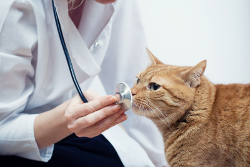Giardia is an intestinal parasite that can be very contagious among cats. Once one cat is infected, it’s very quick and easy for another cat to become infected. Fortunately, a giardia infection is not life threatening and can be cleared up, even though doing so may prove to be a bit difficult. This parasite is unique because it doesn’t develop into a worm like other parasites. The official name for a giardia infection is called Giardiasis.
How is Giardia in Cats Contract?
Giardia is not a worm; it is a single-cell parasite. This parasite can also be passed along to other cats and animals; one common way is through an infected cat’s litter box. Even when a cat has the parasite, it might not show any symptoms for many years.
There are several causes for a cat contracting giardia. The most common is the cat swallowing the parasite while it is in cyst form, or by drinking contaminated water if the cat is frequently outside. Once ingested, it will travel to the stomach and eventually make it to the intestines.
Once there, the parasite will live and go through its transitional life stages. The cyst will transform into its feeding form and will attach itself to the intestinal wall where it will feed until it is passed in the cats stool. Once passed, it is highly contagious and can be passed to other cats almost instantly.
If many are present and attached to the intestinal wall, there can be substantial damage done and signs will start to develop. Giardia is way more common in kittens and younger cats and is harder to find in older cats. This is also something that is easily transmitted in places where there are multiple cats like a boarding house, animal shelter or even a pet store.
Signs, Symptoms, and a Diagnosis of Giardia in Cats
 There are symptoms that may tell you if your cat possibly has the parasite but it could possibly take several years before your cat will start showing symptoms. These parasites are microscopic and cannot be seen by the naked eye when passed in the stool. In fact, the only way to see these microscopic parasites is by a fecal smear under a microscope. Even then, it may be had to tell with just a fecal smear. Your veterinarian may have to conduct several tests and use different flotation solutions to get an exact determination.
There are symptoms that may tell you if your cat possibly has the parasite but it could possibly take several years before your cat will start showing symptoms. These parasites are microscopic and cannot be seen by the naked eye when passed in the stool. In fact, the only way to see these microscopic parasites is by a fecal smear under a microscope. Even then, it may be had to tell with just a fecal smear. Your veterinarian may have to conduct several tests and use different flotation solutions to get an exact determination.
Just because you can’t see them doesn’t mean that there aren’t other signs that you can look for. The stool will be the easiest way to do this without conducting a fecal exam.
- Diarrhea that has an unusual and putrid stench to it with a more than normal greenish color.
- Depending on how many there are latched on to the intestinal wall there may also be blood in the stool if there has been significant damage done.
- Weight loss as well as less grooming can also be indicators that something is wrong.
These symptoms can also be signs of many other medical conditions in cats including cancer, so the only way to tell for sure is by a veterinarian’s diagnosis.
Treatments for Giardia in Cats
 For treatment, there is typically one medication called Metronidazole that is more commonly used to treat giardiasis. It is an antibiotic that comes in multiple different flavors to help disguise its bitterness. The pills will have to be cut to be able to administer the correct because proper dosage will differ from cat to cat. Sometimes, a cat’s immune system will require several rounds of treatment for it to be effective. Some cats may be unresponsive to this treatment and require different medications.
For treatment, there is typically one medication called Metronidazole that is more commonly used to treat giardiasis. It is an antibiotic that comes in multiple different flavors to help disguise its bitterness. The pills will have to be cut to be able to administer the correct because proper dosage will differ from cat to cat. Sometimes, a cat’s immune system will require several rounds of treatment for it to be effective. Some cats may be unresponsive to this treatment and require different medications.
There are some serious side effects to Metronidazole such as:
- Shallow breathing
- Seizures
- Swelling and/or sores in the face and throat
Most of these symptoms are rare and if one of these symptoms starts to appear in your cat, simply bring it to attention of your vet. Your vet can prescribe a different medication. There are many medications available to treat giardiasis, especially since there may be more than one round of treatment needed to clear up the infection.
Fenbendazole is another medication that is frequently prescribed with Metronidazole. It’s usually prescribed when the cat is dehydrated due to severe diarrhea.
Prevention and Tips for Giardia in Cats
The best prevention is for your cat not to be housed with other cats, such as in a kennel or boarding house. Also, having yearly checks is also recommended since there might not be any clinical signs of a giardia infection. The easiest way to prevent giardiasis, of course, is to always maintain a very clean and sanitary lifestyle for your cats.
Sift all litter boxes regularly to keep clear of waste. This will help prevent the spread of giardia to your other animals through contact with feces. Occasionally using bleach and water to clean the litter box will also ensure that any organisms in the box are killed.
Some other precautions include:
- Always provide fresh, clean water
- Keep all regularly scheduled veterinarian appointments
- Request fecal smears twice a year, once a year at the very least once a year
Since a giardia infection is sometimes hard to detect, the fecal smear will be the most important role in getting a correct diagnosis. So, even though this parasite can be easily transmitted among cats and other animals, it can also be easily prevented as well.
Thanks for visiting www.catdandruffclinic.com, if you liked this article please like us using the side bar .



Comments are closed.